The comprehensive guide to virtual waiting rooms: All your questions answered

You might not have heard of virtual waiting rooms, but you’ve almost certainly been in one. Virtual waiting rooms empower the world’s biggest businesses—from Ticketmaster to The North Face to the Tokyo Metropolitan Government—to deliver on their busiest days. But what are virtual waiting rooms? How do they work? And why do major businesses and organizations use them? Discover everything you need to know about virtual waiting rooms in this definitive guide.
Table of contents
A virtual waiting room is a cloud-based solution used by businesses and organizations to control online traffic to their websites or mobile apps. It prevents website crashes and ensures fairness in high demand situations like ticket onsales, sneaker drops, and government registrations.
Most people experience virtual waiting rooms as a digital queue. You’ll visit Ticketmaster to get the latest tickets to an event, or Snipes to get some hyped sneakers, or your country’s tax site to file your returns, and you’ll find yourself on a waiting page like the one below.
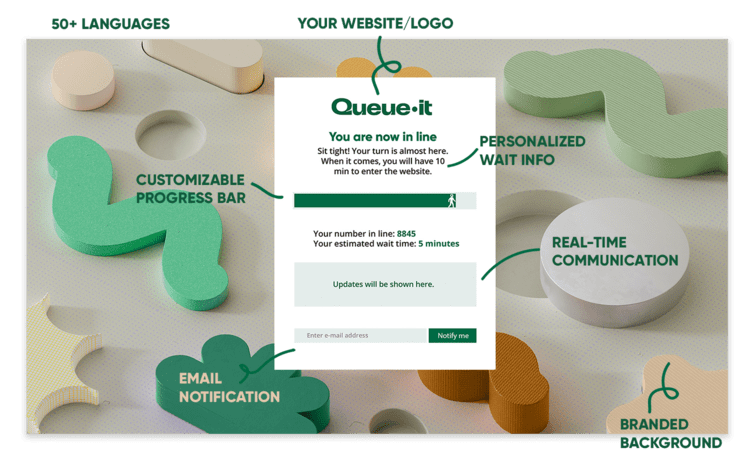
On this page, you’ll see your position in line and your estimated wait time. You can watch the progress bar as you wait or use the email notification feature to get notified when it’s your turn.
When it’s your turn, you’ll be flowed to the webpage or app you were trying to access.
You can watch the typical user experience of a visitor in a virtual waiting room in the video below.
Just like a physical queue, a virtual waiting room is a virtual queue that helps businesses and organizations manage traffic. Managing traffic to websites is important because, just like real-world stores, the experience on the website is improved by limiting the number of people on there at once.
If you’ve seen or taken part in Black Friday sales, you know that a store with too many people in it becomes cramped. People fight over products and push others out of their way. Staff are too busy to assist customers or restock shelves.

Something similar happens when too many people access a website. Some common issues websites and apps suffer due to high traffic include:
- Servers become overloaded, causing slowdowns and/or crashes
- Databases get overloaded, causing inventory errors and overselling
- Third-party services like payment gateways fail, causing errors at checkout
- Other bottlenecks, such as search features or recommendation engines, get overloaded and crash
- Bots get unfair advantages, snatching products before genuine customers
An overloaded website is like a store where the front doors haphazardly lock and unlock, the lights flicker on and off, people push past each other to get products, cashiers can’t do their job, and products on the shelves disappear and reappear at random.
An online waiting room, like a physical queue, prevents this chaos. It keeps the number of people on a site or app at the exact level where a website can perform optimally.
Virtual waiting rooms let you make the most of your business’s moment in the spotlight by keeping your site online, ensuring fair visitor access, and delivering a seamless customer experience. They can help you:
- Ensure website performance: The virtual waiting room lets you control the flow of customers into your site, ensuring you never exceed the technical capacity of your systems and can sell as fast as possible without crashing.
- Improve customer experience: Virtual waiting rooms replace the frustrating experience of a website crash or slowdown with transparent and controlled access, including detailed info on spot in line and estimated wait time on a branded page that can feature interactive elements like videos or games.
- Deliver fair access: In scenarios like limited-time offers or exclusive product launches, a virtual waiting room provides sophisticated fairness mechanisms like first-come-first-served access or live raffle randomization, ensuring all customers get fair access.
RELATED: Virtual Waiting Room Buyer's Guide: How to Choose Your Online Queue System
Virtual waiting rooms automatically redirect visitors to a waiting room when they perform an action the business wants to manage—such as visiting a landing page or proceeding to checkout—or when traffic spikes to levels that threaten site performance.
Customers are seamlessly flowed from the site to a branded waiting room where they see their number in line, their estimated wait time, and a progress bar.
Then, when it’s their turn, they’re automatically flowed back to the site with a unique Queue token that allows them to browse the website without restriction.
While waiting rooms are often customized both in style and in URL to look like the original site, the visitors in them are hosted on the virtual waiting room provider’s servers. This means no strain is placed on the target website’s servers while visitors wait for access.
Virtual waiting room providers typically have huge amounts of server capacity available to them, but also benefit from holding visitors on a lightweight page where they can’t perform complex actions. This means they can comfortably hold just about as many visitors as you want to throw at them.
Queue-it’s virtual waiting room solution, for instance, is hosted on robust and highly scalable AWS servers and uses data centers across Europe, North America, South America, and the Asia-Pacific.
Queue-it has processed over 100 billion site visits across over 10 years and averaged over 75 million visitors per day across 2024. So you can be certain your traffic can be handled by the virtual waiting room solution, no matter how big the event you’re planning is.
Virtual waiting rooms can be configured to work in three key ways, depending on the type of event: (1) the scheduled sale or registration, (2) the safety net, or (3) the exclusive or early access sale.
Discover the virtual waiting room that’s right for you

If you’re holding a scheduled sale or registration, for instance, a product drop, a ticket onsale, or a public sector registration that becomes available at a specific time, you can use the virtual waiting room as a pre-queue.
In this use case, when early visitors hit the designated page, they’re redirected to a branded waiting room with a timer that counts down until the sale or registration goes live.
When the timer hits zero, all visitors in the pre-queue are randomized, just like a raffle, and are flowed to a queue in their randomly assigned order. Visitors who arrive later are added to the back of the queue and proceed to the event in a first-in, first-out order.
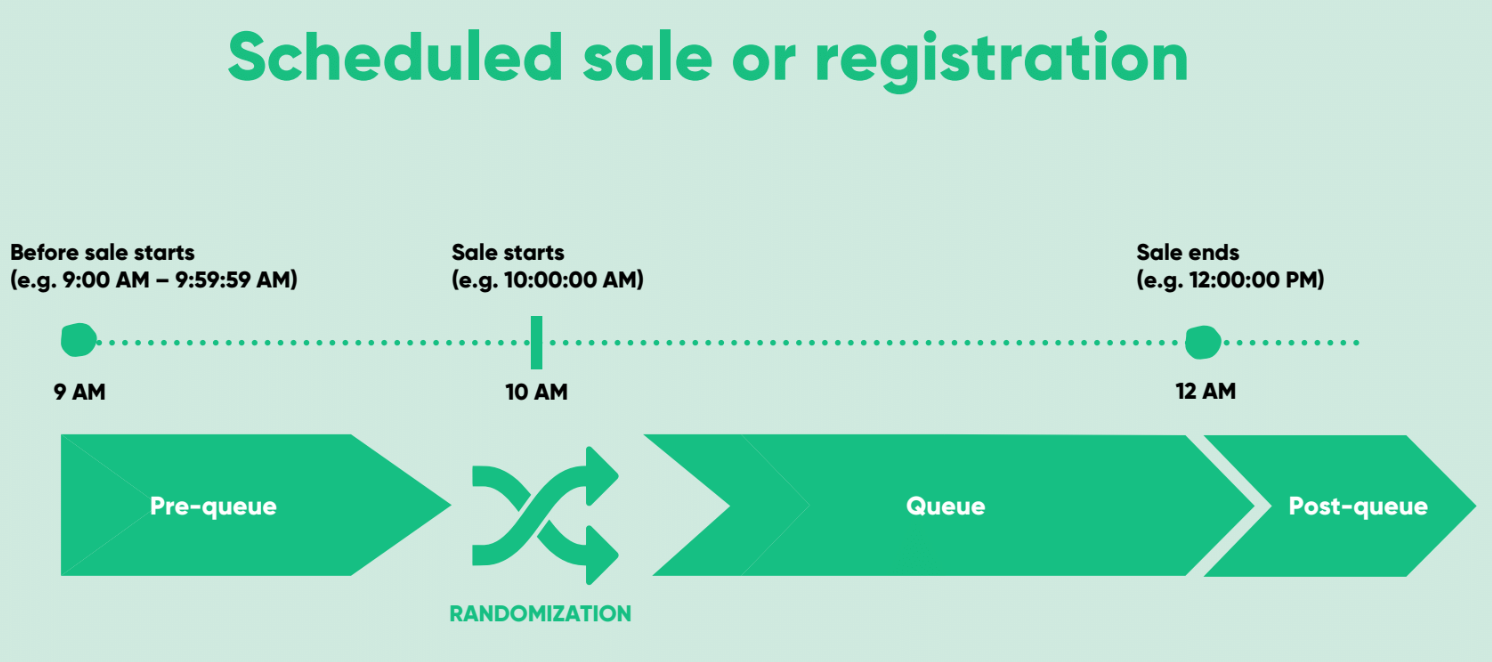
The carousel below shows the three stages of the user journey when a waiting room is used for a scheduled event, in this case, a sneaker drop.
Customers see a page with a countdown timer, then a queue page with detailed wait info, then they're flowed to your site to make their purchase.
Using the virtual waiting room in this way allows you to deliver fairness and reliability throughout the event lifecycle by protecting against traffic spikes and removing the unfair speed advantages of bots.
The traffic data below shows how Brazilian ticketing company Ingresso uses the pre-queue when running scheduled ticket onsales for one of the world's biggest music festivals, Rock in Rio.
Ingresso activates the waiting room pre-queue mode before the onsale goes live. From around 5:45 p.m., all early visitors are automatically redirected from Ingresso's site to the pre-queue countdown page.
When the sale goes live at 7 p.m., these visitors are randomized, and Ingresso starts flowing traffic from the waiting room to their site at the rate they choose.
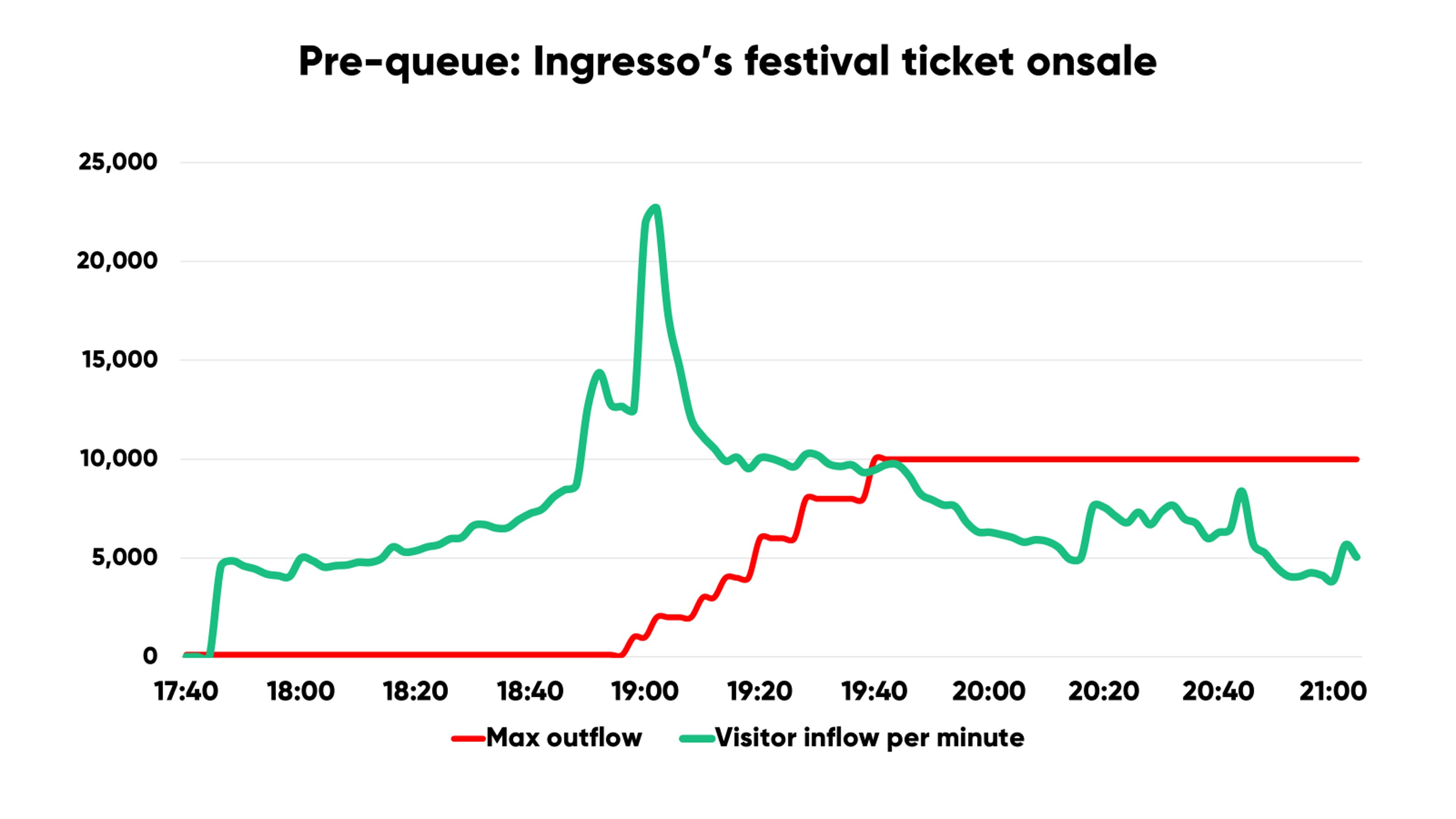
As the green line (visitor inflow) in the chart above shows, eager customers visited Ingresso's site long before the event actually went live, arriving in volumes of over 10,000 per minute.
The pre-queue protects the site from these early spikes and ensures fair access for the customers. But it also gives Ingresso complete control over the rate at which visitors are flowed to the site.
The red line (max outflow), shows how Ingresso slowly increased the outflow from waiting room to site throughout the onsale, ensuring they didn't encounter any issues as they scale up their infrastructure.
“Rather than having that line keep climbing and crashing down, Queue-it let us put it firmly in the middle, so we could sell smoothly and reliably. We’re able to sell much more tickets this way than when we’re dealing with huge spikes and falls.”
ROBERTO JOSE, HEAD OF TECHNOLOGY

A virtual waiting room can also be used as a safety net that only activates when traffic reaches a set threshold. Used in this way, the virtual waiting room guards your site against both expected and unexpected traffic spikes 24/7. Queue-it customers often call this feature their “insurance policy”.
In this use case, businesses and organizations establish the traffic levels at which they experience performance issues, then configure the waiting room to only activate when traffic climbs close to those levels.
This means most site visitors never see the virtual waiting room or need to queue for access, but the site is protected against bots and load-induced performance issues or website crashes nonetheless.
The safety net gives round-the-clock protection from unexpected spikes in traffic, which often occur when a business or organization is mentioned in the news, shown off by a celebrity or influencer, or goes viral on social media.
The traffic data below shows how Queue-it's safety net is used by the U.K.'s online passport application service, Home Office.
As a critical public service, Home Office is expected to stay online 24/7/365, no matter the demand. But the site regularly experiences unexpected spikes in traffic, such as when they're mentioned on the news, linked to in an article, or when there's a rush on new passports ahead of summer vacations.
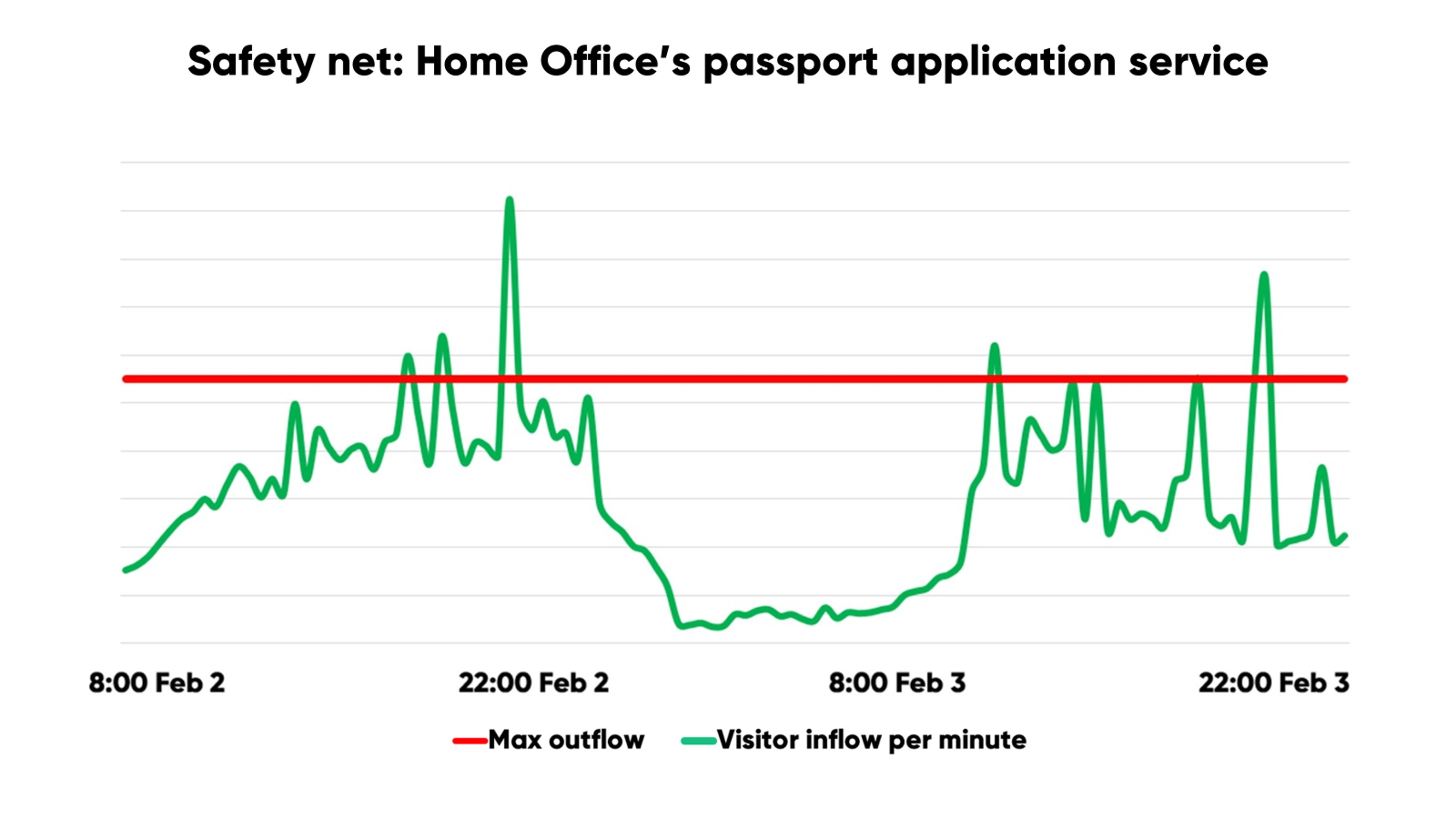
You can see how, across two ordinary days, traffic to Home Office's site experiences several sudden and dramatic peaks that exceed their maximum capacity.
But because the site has 24/7 visitor peak protection, these spikes don’t result in a crash, slowdown, or other issue. Instead, whenever the traffic threshold is reached, the waiting room activates to protect the site.
Visitors are placed in a first-in, first-out queue, and are flowed back to the site when it’s their turn. New visitors will continue to be redirected to the waiting room until site traffic is back below the threshold, then the site returns to normal.
“Paying for super scaled up infrastructure is pointless when we don't need it most of the time. Queue-it offered that extra level of security and the ability to control the traffic spikes. It’s a very cost-effective way of managing demand."
KEVIN LEWIS, PRODUCT MANAGER

The virtual waiting room can also be used to engage and grow your loyal customer base through granting exclusive or early access. This feature is called the invite-only waiting room.
The invite-only waiting room enables businesses to deliver smooth and secure exclusive experiences to customers.
It empowers you to incentivize email signups and offer exclusive benefits for newsletter subscribers, loyalty program members, and valued customers. Plus, it enables you to deliver exclusivity at scale by ensuring bots and non-members can’t abuse your sales and product drops.
Using an invite-only waiting room, you can:
- Control sales access for true exclusivity
- Engage & grow your customer base
- Analyze sale success & customer behavior
To set it up, you simply:
- Upload the list of customers you want to invite to your event or give early access to
- Send out unique, single-use links OR add an email verification field to your waiting room page
- Run your event, confident no one but the people you want can get access
RELATED: Control Sales Access to Engage & Grow Your Customer Base
The chart below shows how cycling apparel brand Rapha used Queue-it to give members early access to a hyped product drop.
They set up two waiting rooms. One that could be accessed by anyone, and one exclusively accessible by members.
On the morning of the drop, they activated both waiting rooms in pre-queue mode to gather early visitors. At 11:00 a.m., they started flowing only visitors in the loyalty members' queue to their site.
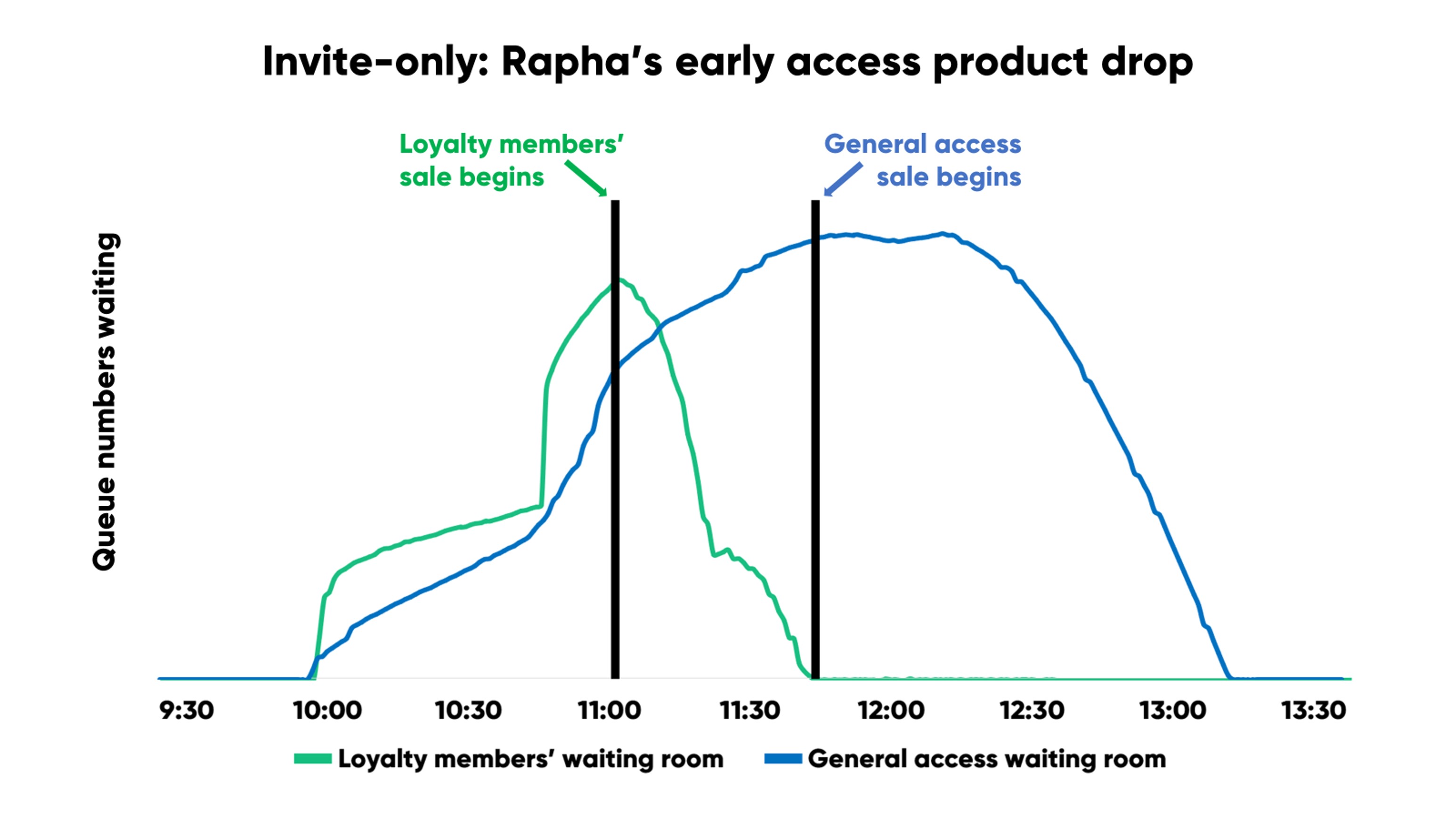
Rapha monitored traffic in the Go Queue-it Platform, waiting until all members had progressed from queue to website and had a chance to purchase. Then, at 11:45 a.m., they started flowing traffic from the general access waiting room to their drop.
This strategy allowed Rapha to ensure secure early access for members while protecting their site, blocking bots, and giving members of the general public a fair experience.
“Our members expect to get the benefits they pay for. Queue-it helped us deliver the exclusive drop access members were promised and gave us the peace of mind the website would be there for them.”
TRISTAN WATSON, ENGINEERING MANAGER

Major businesses and organizations use virtual waiting rooms to create a fair, reliable, and seamless online experience, no matter the demand. You'll typically see virtual waiting rooms on websites that experience large, sudden traffic peaks that far exceed their usual capacity.
The Ticketmaster waiting room, for example, is used to handle the traffic that comes during massive concert ticket sales. The queue also helps Ticketmaster block ticket bots and ensure fair access for site visitors.
But waiting rooms are used by a wide variety of organizations across industries and use cases, including:
- SNIPES during hyped sneaker drops
- Peach Aviation during airline ticket flash sales
- London School of Economics during class registrations
- Currys during the Holiday Season
- The North Face during exclusive product drops
- Bend Parks and Recreation during recreation activity registrations
- Sky Mobile during iPhone launches
Virtual waiting rooms keep all these organizations' websites online and running smoothly on their busiest days—protecting their revenue, reputation, and customer trust and loyalty.
But taking control of web traffic with a virtual waiting room isn’t just a defensive measure. It can unlock major benefits across businesses. It saves money, frees up resources, and enhances the customer experience. It gives companies the confidence to run major online events and delight customers without the risk of failure.
In a recent survey, Queue-it customers identified three key reasons they use a virtual waiting room:
1. To improve the customer experience
- 84% say their customers’ online experience has improved
- 69% saw fewer customer complaints for sales/registrations
- 85% say their sales are fairer with Queue-it
- 46% say their insight into genuine & malicious traffic has improved
2. To increase productivity & efficiency
- 76% say running sales/registrations is less stressful
- 48% average reduction in staff needed on-call during sales/registrations
- 85% sell through product more efficiently
3. To save on scaling costs
- On average customers report a 37% decrease in server scaling costs
- On average customers report a 33% decrease in database scaling costs
RELATED: Queue-it Customer Survey: Real Virtual Waiting Room Results from Real Customers
Now, the technically inclined might be wondering, “Why don’t these companies just scale to get more capacity? Why do they need an online waiting room?”
They do. But at scale, every system breaks.
There is no “too big to fail” in the world of websites. Amazon, Walmart, Apple, the IRS—surging web traffic has taken all of them offline.
If you’re preparing for a large spike in traffic, you’ll want to optimize your website in many ways, including scaling your systems.
But scaling alone is expensive at best, and risky at worst.
- Expensive: Most websites are built to perform under their usual amount of traffic. Building a website that can handle huge traffic peaks that only come a few times a year is like buying a house with 10 extra bedrooms and bathrooms because your family comes to visit sometimes—it’s expensive, impractical, and unnecessary.
- Reactive: Because traffic levels are hard to predict and autoscaling takes time to kick in, your systems likely won’t be ready in the critical moment they’re needed.
- Risky: Even if autoscaling or pre-scaling could handle these surges, bottlenecks almost always emerge. This means traffic still overloads areas that are difficult or impossible to scale, such as databases, inventory management systems, third-party features like payment gateways, and performance-intensive features like dynamic search or a “recommended for you” panel.
RELATED: 3 Autoscaling Challenges & How To Overcome Them With a Virtual Waiting Room
Consider the following real-world traffic spike Rakuten France experienced when a representative appeared on the national news.
6,000 visitors rushed to their site in a single minute—5x more than their site could ordinarily handle.
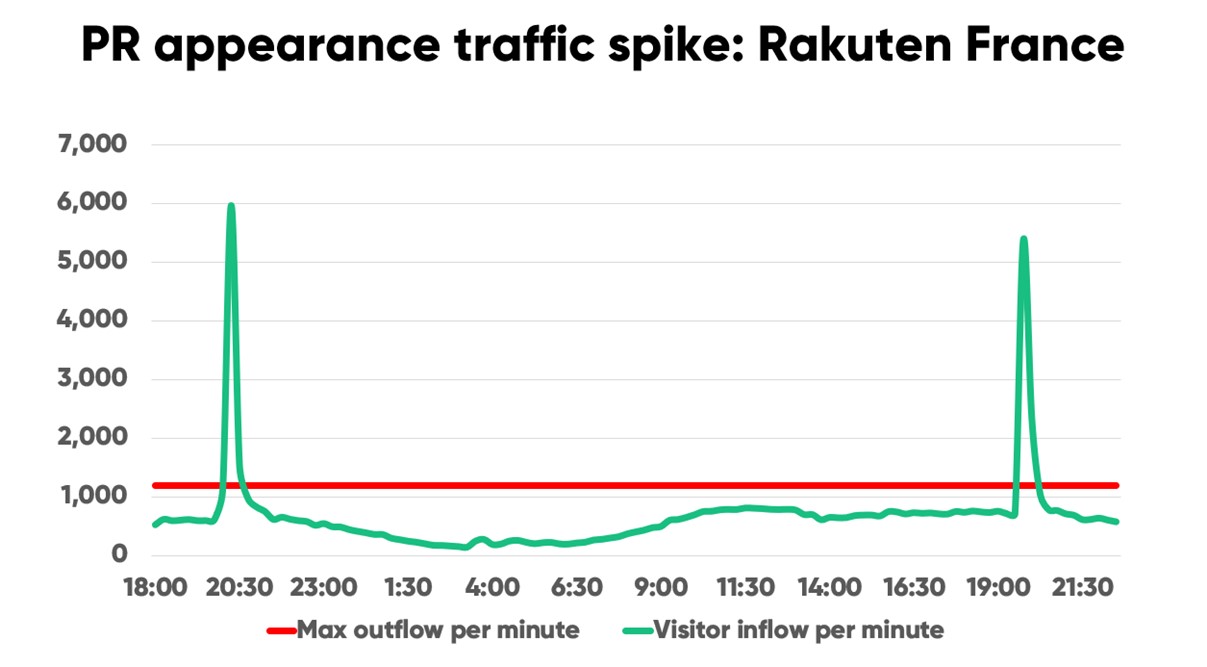
For large spikes like this, Rakuten France’s Infrastructure Manager Thibaud Simond says, “We can’t have a reaction that takes even a minute.”
That rules out autoscaling (reactive and risky).
Their next option would be to pre-scale their systems for the event. But there's a few issues with this, too. They didn't know exactly when the segment would air and didn't know how many visitors would show up. So the team would either need to dramatically overprovision resources (expensive), or make a reasonable prediction and scale to that point (risky).
And that's assuming Rakuten's infrastructure can scale to handle 6,000 visitors in a minute. More likely, they'd need to do significant testing, optimization, and potentially re-architect their systems and upgrade subscription tiers with third-party providers (expensive).
Rakuten chose to protect their site with a virtual waiting room because it “reacts instantaneously to our peaks before they impact the site experience,” Simond says. “It lets us avoid creating a bunch of machines just to handle a 3-minute traffic peak, which saves us time and money.”
Virtual waiting rooms control what autoscaling and other crash-prevention tactics can’t: the flow of online visitors.
It complements autoscaling, enabling you to proactively protect your site against sudden spikes, safeguard key bottlenecks, and ensure scaling costs don’t get out of control. And as a bolt-on tool, the virtual waiting room doesn’t require you to re-architect systems for high-traffic events that only occur a few times a year.
"Nobody builds a website to handle hundreds of thousands of people just for a limited amount of time. Throughout the day it’s different, but having that major peak is insane. Queue-it is a great solution that saves the day and it works flawlessly."
Robert Williams, Digital Manager

Discover what a virtual waiting room can do for you

When customers or citizens use a website or app, they have four core needs. Aaron Walter’s Hierarchy of User Needs sets out that systems should be functional, reliable, usable, and pleasurable—in that order.
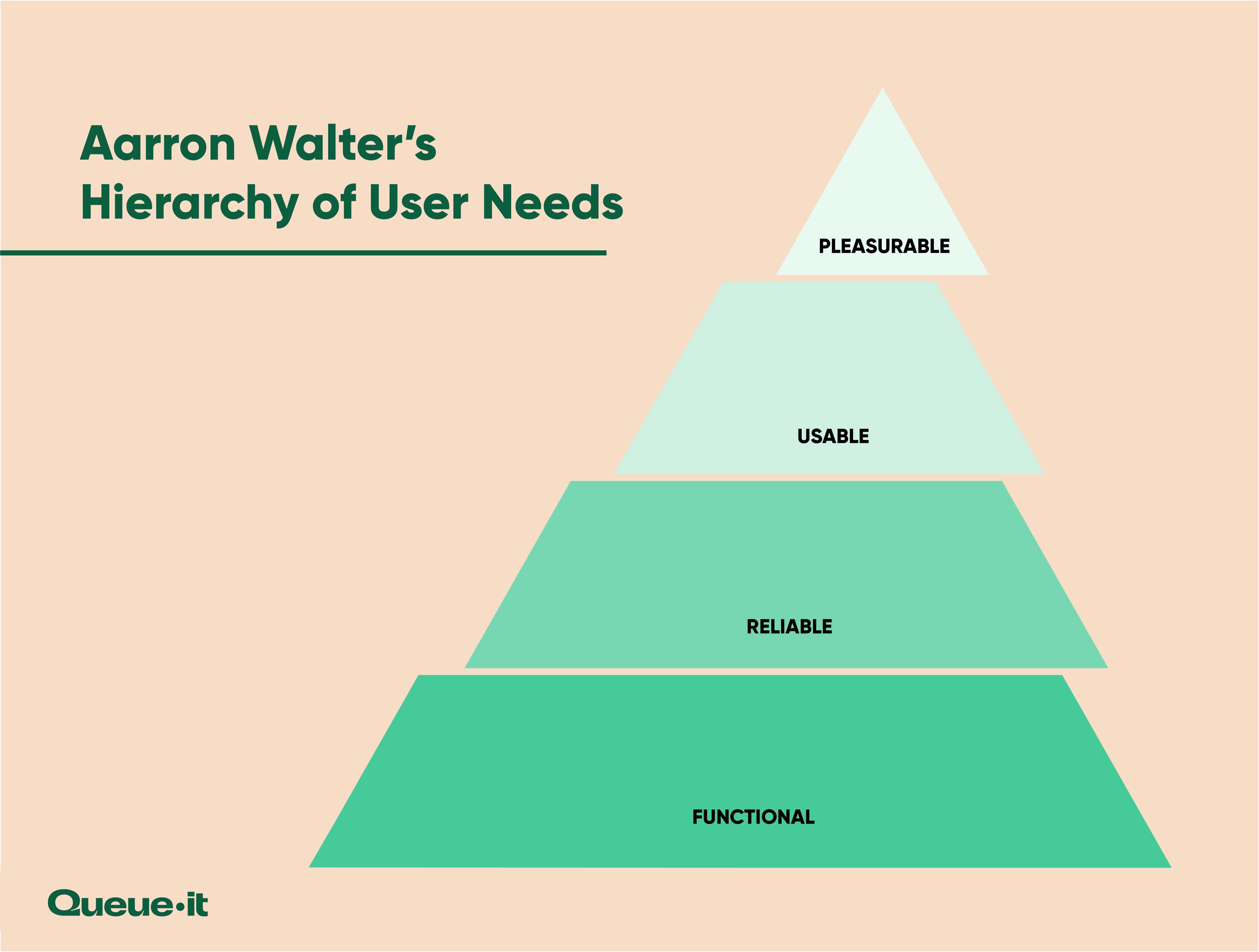
When a website crashes, slows down, or suffers errors, this whole hierarchy comes toppling down. That’s why the key benefit of a virtual waiting room is ensuring that those three most foundational needs—functionality, reliability, and usability—are firmly in place, so you can deliver a pleasurable experience to every visitor.
Website crashes are expensive. 91% of enterprises report downtime costs exceeding $300,000 per hour. But beyond the dollar costs, slow and crashed websites are terrible for the user experience. They frustrate customers, break down trust, and threaten loyalty by delivering the worst kind of customer experience possible—none at all.
1 in 3 customers will leave a brand they love after one bad experience, and 92% will completely abandon the brand after two or three negative interactions.
RELATED: Cost of Downtime: IT Outages, Brownouts & Your Bottom Line
Queue-it’s virtual waiting room improves customer experience by keeping your site online and preventing issues caused by high traffic. But it also includes many features that actively improve the user experience by facilitating communication, excitement, and fairness for customers. With Queue-it, you can:
- Entertain visitors while they wait with videos, games, and playlists
- Send real-time inventory updates and messages to customers in queue
- Ensure a seamless experience by completely customizing your waiting room
- Let customers transfer their queue position between devices
- Send email notifications to customers when it's their turn
- Deliver a waiting experience grounded in the tenets of queue psychology by providing detailed wait information, showing users their progress, keeping them occupied, and delivering a fair experience
RELATED: 11 Ways To Customize Your Waiting Room For a Better User Experience
“The feedback on Queue-it has been kind of overwhelmingly positive. It's anecdotal, but I’ve seen tweets and emails from people that said ‘Thanks, it was a really great experience.’ Or, you know, ‘I got the ticket I wanted and I loved the give us your email feature.’”
JON HAWORTH, SR. COMMERCIAL SYSTEMS MANAGER

A lot of the businesses and organizations that choose to work with Queue-it face a mismatch between supply and demand.
Where there's more demand than there is supply, competition emerges. People rush to get first access, creating large and sudden spikes in traffic. Some visitors get what they wanted, others miss out. This is one of the key reasons virtual waiting rooms for tickets are so common—because there's often fewer tickets than there are people who want them, so traffic typically arrives in sudden peaks.
We see this same competitive scenario occur across a wide range of use cases and industries, such as limited-edition product or sneaker drops, large flash sales like Black Friday, high-profile public sector registrations, and higher education class or housing registrations.
In all these scenarios, people use bots to gain a competitive advantage.
These bots arrive in huge volumes, compounding load-induced problems like site overload and overselling. But they also create new issues:
- Bots harm customer trust & loyalty
- Bots make you miss connections with genuine customers
- Bots jeopardize business and partnership contracts
- Bots increase operational & support costs
- Bots create faulty analytics for decision making
RELATED: Everything You Need to Know About Preventing Online Shopping Bots
Bad bot traffic creates real, concrete costs. But working to keep resellers off your site isn’t just practical, it’s ethical.
Real customers love your products. Resellers love the profit they can make off them. Who would you rather sell to?
A virtual waiting room keeps bots off your site like a security checkpoint at an airport keeps bad actors off flights. It sits between a webpage on your site and the purchase path. As visitors flow through it in a controlled, orderly manner, you can run identification checks that determine whether they get to pass through.
The “identification checks” for identifying and stopping bots with Queue-it’s virtual waiting room include:
- Data center blocking
- Proof-of-Work challenges
- CAPTCHA tests
- Blocking or challenging traffic based on reputation scores
- Blocking or challenging traffic based on anomalous behavior
- Randomization of traffic
- Invite-only access management
With bots and abuse protection features enabled, the waiting room not only lets you control the flow of traffic, but also the quality of traffic. It empowers you to filter out bad actors to create a fair and smooth product drop experience you can take pride in.
Queue-it's "live raffle" pre-queue system for scheduled events is also designed to improve fairness for genuine users by ensuring all visitors who arrive on time for a sale get a fair and equal shot at site access.
Ticketmaster has blocked over 13 billion bots across more than 17,000 events using Queue-it’s virtual waiting room.
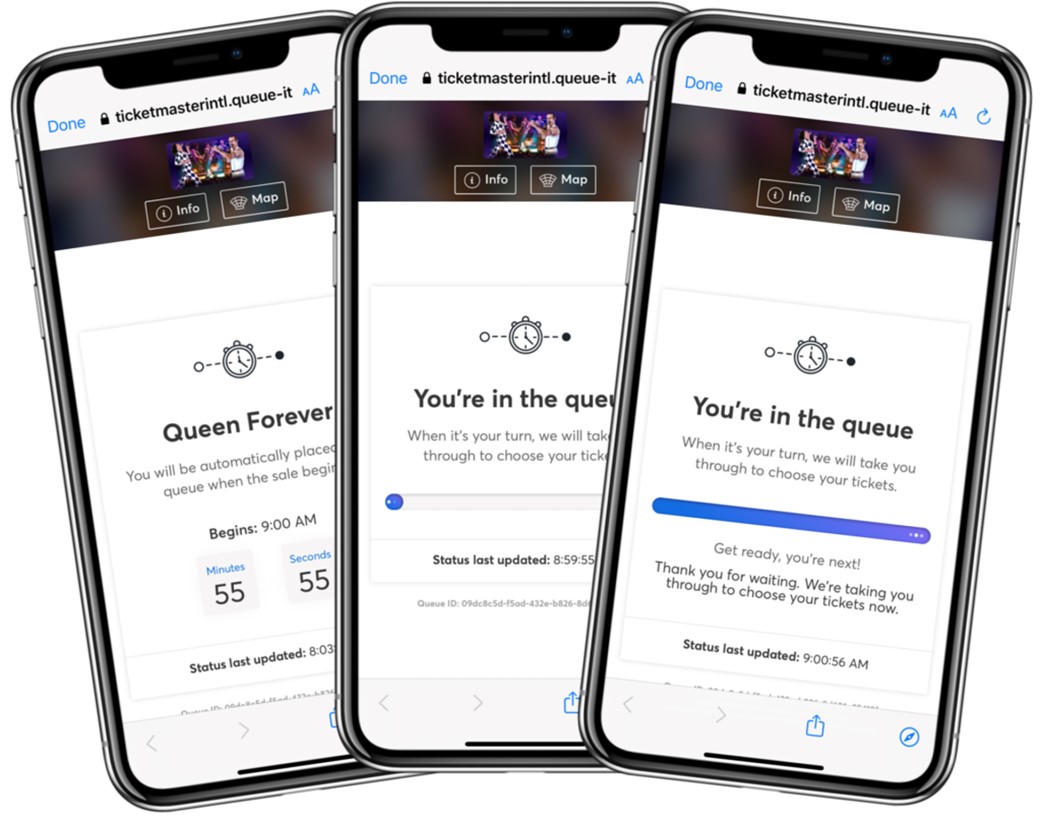
The cruel irony of website crashes due to high traffic is they occur when businesses and organizations are at their most visible.
When you’re launching your new product, promoting major Black Friday sales, running a marketing campaign, distributing stimulus checks, or releasing tickets for a major artist, there’s massive pressure to deliver on demand and ensure a successful event.
The eyes of the public, the media, key stakeholders, and management are on you and your event. And as anyone who’s worked for a company or organization executing on high demand events knows—this makes them very stressful.
When Andrew Roberts and his team released vaccination records to the Canadian province of Newfoundland & Labrador, they “saw huge amounts of traffic all at once. We had thousands and thousands of people every second trying to come in and get their vaccine records. … The media was posting a bunch of things about the site crashing. Social media was blowing up about it. So, you know, there was a lot of pressure on us that day.”
That’s why capturing control over traffic and getting “peace of mind” is what Queue-it customers say time and time again is the biggest benefit of using a virtual waiting room.
When businesses or organizations use a virtual waiting room for a scheduled event, they have confidence no matter how successful their marketing is, no matter how many people want their new service, product, or ticket—they can handle the demand.
And when used for 24/7 protection, website managers can rest easy, certain that if the unexpected occurs, the waiting room will activate and protect the site.
The GO Queue-it Platform also enables businesses and organizations to adjust and control traffic on the fly. This means if they accidentally let too many visitors in, face an unexpected issue, or find an unanticipated bottleneck, they can simply lower the traffic inflow or pause the queue.
In the event something on the backend does go wrong, visitors aren’t booted from the site and left to frantically refresh the page. The queue can simply be paused while the team fixes the issue and visitors can be informed of the delay using the communication pane.
"The peace of mind we get from using Queue-it is outstanding. The best thing is feeling relaxed, not having to worry, knowing that everything will be okay. The virtual waiting room reacts to and controls our traffic instantaneously ... The benefit is real, and the ‘sérénite’ is real, too."
Thibaud Simond, Infrastructure Manager

Most companies begin using a virtual waiting room to protect their site against peaks in online traffic. But after using the solution for some time, many return reporting a more unexpected benefit: higher conversion rates.
"We saw an enormous increase in conversion rates," says Joost Van Der Veer, CEO of Winkelstraat.nl.
There's a few key ways virtual waiting rooms can increase conversions and sales:
- Social proof: An online queue works like a physical queue to show off the popularity of a product or event. By displaying to all visitors the number of people waiting in front of them, you signal to customers they’re not alone in their decision to purchase. That the product they want is popular. That others want it too.
- Scarcity marketing & competition: When products are limited in quantity, showing social proof creates competition, which supercharges customers’ desire for products. When customers see products selling out and that thousands of others are trying to get onto the website at the same time, conversions skyrocket. Why? Because the waiting room sends them a clear message: if they don’t buy, someone else will.
“People get put in a queue and they think, ‘Oh wow, this event is popular, it’s going to sell out, I have to buy tickets to it.’ They see that so many other people are interested. I think that’s why we see higher conversion rates in our sales that have queues.”
MIJAIL PAZ, HEAD OF TECHNOLOGY

- Cross-selling & showing off products: Many customers visit your website with a specific product in mind. When they're placed in a waiting room, you get a unique opportunity to affirm their decision to purchase and showcase your other offerings. Queue-it is fully customizable, meaning many companies get creative and use their waiting room as a piece of marketing material—adding videos, product imagery, promo codes, and signup forms for loyalty programs. When customers are in your waiting room, you have their attention. If you make the most of that attention, you can boost your sales once they proceed to your site.
RELATED: How You Can Optimize Conversions With a Virtual Waiting Room
“Being able to show how many people want the product helped us create hype and enhance our brand power. It’s a bit like how the popular kids at school get even more popular. We saw this especially in the cross-selling effect on our other products, which tripled in sales during the drop.”
TAISHI MIZUNO, CHIEF MERCHANDISING OFFICER

By now you should know everything you need to know about what virtual waiting rooms are and why businesses and organizations use them. As a quick recap:
- A virtual waiting room is a cloud-based solution used by businesses and organizations to control online traffic to their websites or mobile apps.
- Controlling traffic to websites is important because, just like real-world stores, the experience on the website is improved by limiting the number of people on there at once.
- Virtual waiting rooms protect against traffic-related issues like site crashes, slowdowns, and technical errors.
- Virtual waiting rooms work by redirecting traffic from a target page to a waiting room, then throttling that traffic back to the site at a rate the site can handle.
- Major companies and organizations use virtual waiting rooms to prevent load-induced issues like crashes, slowdowns, errors, and overselling.
- But virtual waiting rooms aren't just a defensive tool. They're also used to improve your online customer experience, block bots and deliver fairness, give you control and peace of mind, and empower you to capitalize on the opportunity of peak traffic by optimizing conversions and cross-selling.
Queue-it is the market leading virtual waiting room solution, having served over 100 billion users across 172 countries. With a mission to create trust-building online experiences, Queue-it empowers the world’s biggest businesses to perform on their busiest days. When Ticketmaster, Rakuten France, and the Tokyo Metropolitan Government need to manage high demand events, they turn to Queue-it.






